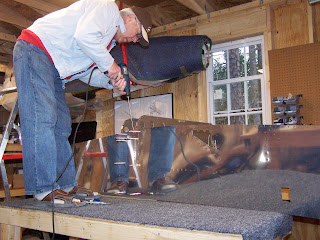
Now we are talking!
Feel free to enlarge the picture for details. This section covers 20 pages, when I'm finished with it the weather outside will be much warmer!
Building an RV-12 LSA from a kit by VANs aircraft and learning to fly Light Sport Aircrafts = the full Wright Brothers experience!







 ...the left one, one to go, the right one.
...the left one, one to go, the right one.







 The fuselage kit is neatly organized into 10 subkits that are wrapped as bundles plus a dozen individual parts, mostly skins and bulkhead frames.
The fuselage kit is neatly organized into 10 subkits that are wrapped as bundles plus a dozen individual parts, mostly skins and bulkhead frames.
 This is the storage occupied by the fuselage kit. There is surprisingly little on the shelves although some subkits are hidden by the tailcone. I think that parts will spread when I unwrap the 10 subkits. All skins are on the top shelf as well as the rear window of the cockpit and are not very visible on the picture.
This is the storage occupied by the fuselage kit. There is surprisingly little on the shelves although some subkits are hidden by the tailcone. I think that parts will spread when I unwrap the 10 subkits. All skins are on the top shelf as well as the rear window of the cockpit and are not very visible on the picture.